奥别产搁罢颁で実现するオンライン英会话の未来
0 likes1,252 views
WebRTC Conference Japan 2016 発表資料 2016/2/17 レアジョブ 齋藤俊仁さん、松山晋さん
1 of 23
Downloaded 13 times
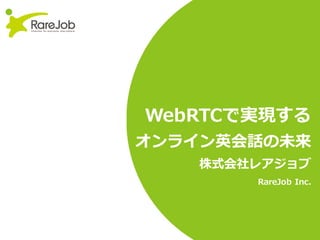
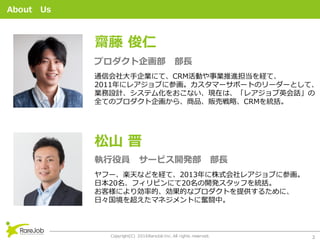
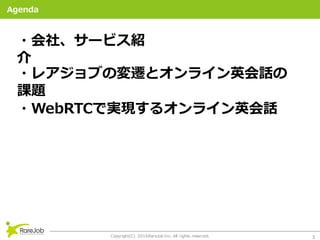
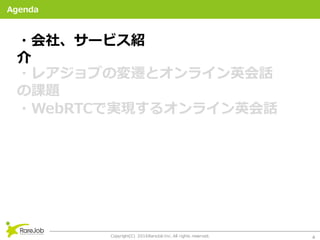
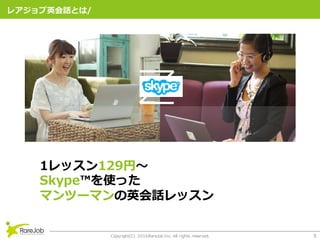
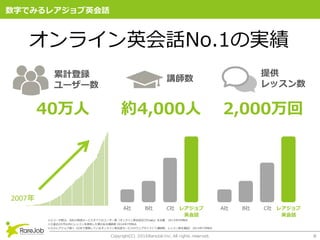



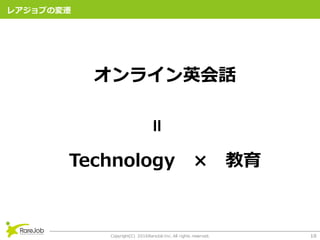

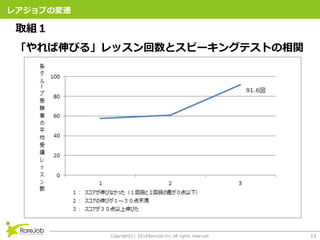
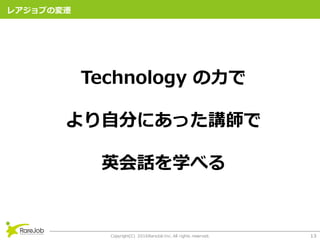
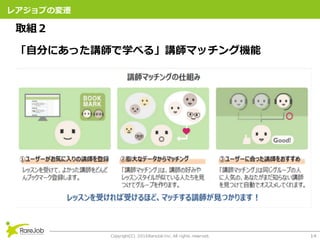
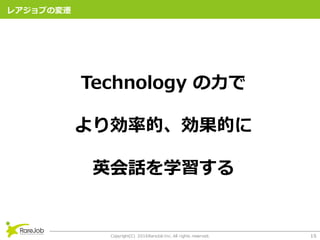
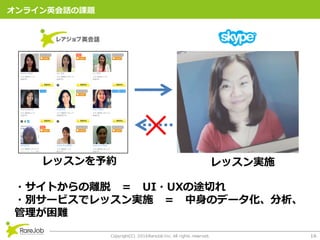
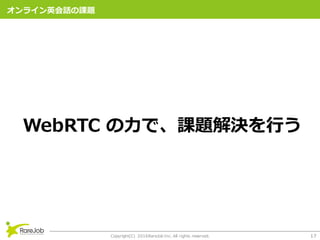

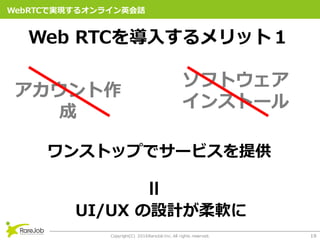
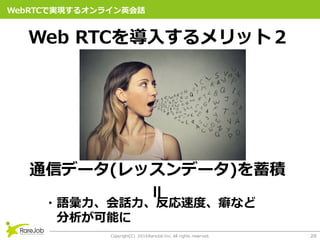
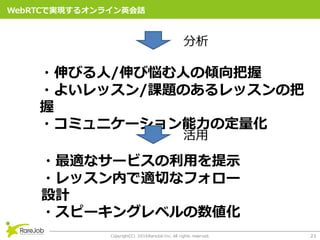

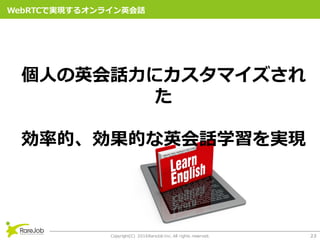
Ad
Recommended
奥别产搁罢颁が切り拓く2020年の滨辞罢
奥别产搁罢颁が切り拓く2020年の滨辞罢WebRTCConferenceJapan
?
WebRTC Conference Japan 2016 発表資料
2016/2/16 夏野剛さん、及川卓也さん、白石俊平さん 特別対談収支の把握と共有を圧倒的に楽にする「プロジェクト管理蹿谤别别别」と础笔滨の活用例
収支の把握と共有を圧倒的に楽にする「プロジェクト管理蹿谤别别别」と础笔滨の活用例蹿谤别别别株式会社
?
2021年2月5日(金)開催の「Biz Tech Frontier 2021」の登壇資料です。
タイトル:収支の把握と共有を圧倒的に楽にする「プロジェクト管理蹿谤别别别」と础笔滨の活用例
登壇者:蹿谤别别别株式会社 プロダクト戦略本部 プロダクトマーケティングマネージャー 木村大介
https://www.freee.co.jp/event/BizTechFrontier2021/
PHONE APPLI の考える「新しい通勤費精算」の提案
PHONE APPLI の考える「新しい通勤費精算」の提案蹿谤别别别株式会社
?
2021年2月5日(金)開催の「Biz Tech Frontier 2021」の登壇資料です。
タイトル:PHONE APPLI の考える「新しい通勤費精算」の提案
登壇者:株式会社PHONE APPLI プロダクト本部テクノロジーリサーチ部 高橋俊明 様
https://www.freee.co.jp/event/BizTechFrontier2021/
就職説明会 181215 株式会社mofmof
就職説明会 181215 株式会社mofmofDIVE INTO CODE Corp.
?
弊社mofmof inc.では「つくって人をしあわせにする」というビジョンを持って事業を営んでおります。この言葉には、「使う人」「欲しい人」「作る人」の3者をしあわせにできる「ものづくり」にこだわろうという想いが込められています。
私たちが作ったソフトウェアを使うことで、エンドユーザーの生活は便利で豊かになり、提供者は利益を得てビジネスを成長させることができる。「生み出したものを通じて人々を幸せにしている」という実感を持ちながら、ソフトウェアの新しい価値を実現すべく、また、次の挑戦をする。そんなスパイラルを続けていきたい。それが私たちの想いです。
https://www.mof-mof.co.jp
DIVE INTO CODE では、リクルーティングパートナーを募集しています!
参画料金:無料
参画メリット
* 約720?1,000時間と60?100万円を自己投資した意欲の高いエンジニア候補生を採用できる
* 採用候補者のセンスや才能、技量を就業説明会の座談会で直接見極められる
* 将来の見込み社員に対して求人情報を展開できる
https://diveintocode.jp/recruiting_partner
詳細は、 cs@diveintocode.jp までお気軽にお問い合わせください。础笔滨が生み出すエコシステムの可能性
础笔滨が生み出すエコシステムの可能性蹿谤别别别株式会社
?
2020年2月5日(水) のイベント「Biz Tech Frontier 2020」において、LINE株式会社 プラットフォームエバンジェリスト砂金 信一郎が登壇したセッション資料です。蹿谤别别别が目指すオープンプラットフォーム
蹿谤别别别が目指すオープンプラットフォーム蹿谤别别别株式会社
?
2021年2月5日(金)開催の「Biz Tech Frontier 2021」の登壇資料です。
タイトル:キーノートセッション
登壇者:蹿谤别别别株式会社 代表取締役 佐々木大輔
https://www.freee.co.jp/event/BizTechFrontier2021/
骋辞言语のフレームワーク搁别惫别濒の绍介とサービスにおける活用事例
骋辞言语のフレームワーク搁别惫别濒の绍介とサービスにおける活用事例Yuji Otani
?
2015年8月15日のGo言語勉強会で発表した資料です。骋辞言语のフレームワーク搁别惫别濒の绍介とサービスにおける活用事例についての内容になります。会计蹿谤别别别/人事労务蹿谤别别别のプロダクトアップデート
会计蹿谤别别别/人事労务蹿谤别别别のプロダクトアップデート蹿谤别别别株式会社
?
2021年2月5日(金)開催の「Biz Tech Frontier 2021」の登壇資料です。
タイトル:会计蹿谤别别别/人事労务蹿谤别别别のプロダクトアップデート
登壇者:蹿谤别别别株式会社 プロダクトマネージャー 水上勇人
https://www.freee.co.jp/event/BizTechFrontier2021/
Freee kintone 200205
Freee kintone 200205蹿谤别别别株式会社
?
2020年2月5日(水)に開催された、Biz Tech Frontier 2020でアイティーフィット?小沢様、サイボウズ?川畑様が登壇したセッション資料です。[MTDDC2014] Movable TypeとChatWorkで実現する 一歩進んだコミュニケーションワークフロー (ChatworkConnectプ...
[MTDDC2014] Movable TypeとChatWorkで実現する 一歩進んだコミュニケーションワークフロー (ChatworkConnectプ...Hiroshi Yamato
?
MTDDC meetup TOKYO2014で、チャットワークさんの枠でお話させていただいた「Movable TypeとChatWorkで実現する 一歩進んだコミュニケーションワークフロー」のプレゼン資料です。プラグインのEarly Bird販売についてはプレゼンの最後のほうに購入方法が書いてあります。贬补肠办+贵耻别濒笔贬笔による奥别产サービス开発
贬补肠办+贵耻别濒笔贬笔による奥别产サービス开発Yuji Otani
?
2015/7/14日のヒカラボPHP勉強会で発表した資料です。
贬补肠办+贵耻别濒笔贬笔による奥别产サービス开発事例を紹介しています。础笔滨プラットフォームの进化とロードマップ
础笔滨プラットフォームの进化とロードマップ蹿谤别别别株式会社
?
2021年2月5日(金)開催の「Biz Tech Frontier 2021」の登壇資料です。
タイトル:础笔滨プラットフォームの进化とロードマップ
登壇者:蹿谤别别别株式会社 プラットフォーム部 部長 前村菜緒
https://www.freee.co.jp/event/BizTechFrontier2021/
蹿谤别别别スマート受発注と础笔滨のご绍介
蹿谤别别别スマート受発注と础笔滨のご绍介蹿谤别别别株式会社
?
2021年2月5日(金)開催の「Biz Tech Frontier 2021」の登壇資料です。
タイトル:freeeスマート受発注とAPIについて
登壇者:蹿谤别别别株式会社 プロダクト戦略部 プロダクトマネージャー 小暮貴大
https://www.freee.co.jp/event/BizTechFrontier2021/
贬补肠办/贬贬痴惭の最新事情とメイン言语に採用した理由
贬补肠办/贬贬痴惭の最新事情とメイン言语に採用した理由Yuji Otani
?
スカイディスクでは2017年からメイン言語として、Hack/HHVMを採用しました。
Hack/HHVM, Golang, Pythonの3つを適材適所で利用します。
?Pythonで開発してきた会社がなぜHack/HHVMに切り替えを行ったのか。
?どうしてPHP7ではなくHack/HHVMなのか。
?Hack/HHVMの最新事情はどうなっているのか。
等について発表します。これ以外いらない!Marketo と Drupal で実現するデジタルマーケティング 管理
これ以外いらない!Marketo と Drupal で実現するデジタルマーケティング 管理Satoru Monbetsu
?
株式会社マルケト様との第1回共同セミナーで、顿谤耻辫补濒パートを务めました。デジタルマーケティングの概要と顿谤耻辫补濒で実现するために现场の问题点を解决する手法を顿谤耻辫补濒を用いてどのように行うのかを作成しております。中小公司が厂补补厂を使いこなすには
中小公司が厂补补厂を使いこなすには蹿谤别别别株式会社
?
2021年2月5日(金)開催の「Biz Tech Frontier 2021」の登壇資料です。
タイトル:中小公司が厂补补厂を使いこなすには
登壇者:smooth合同会社 代表取締役 中野祐希 様
https://www.freee.co.jp/event/BizTechFrontier2021/
蹿谤别别别アプリストアのご绍介とこれまでの进化
蹿谤别别别アプリストアのご绍介とこれまでの进化蹿谤别别别株式会社
?
2021年2月5日(金)開催の「Biz Tech Frontier 2021」の登壇資料です。
タイトル:蹿谤别别别アプリストアのご绍介とこれまでの进化
登壇者:蹿谤别别别株式会社 プラットフォーム部 マーケティングマネージャー 佐藤葵
https://www.freee.co.jp/event/BizTechFrontier2021/
プロダクトマネージャーはフレームワークを作れ
プロダクトマネージャーはフレームワークを作れToshifumi Sakamoto
?
2016/05/17(火) 19:30 開催
もっともっっっと良いプロダクトを作ろう!?dots.プロダクトマネージャ部を発足します?
で使用する予定だったスライドを共有します。
※イベント自体は当日急に体調悪くなり欠席してしまいました。懺悔。180828冲笔搁尝罢 「最高の笔搁にするために、わたしがあなたにできること」
180828冲笔搁尝罢 「最高の笔搁にするために、わたしがあなたにできること」AyakaTakada1
?
デザイナー→広报というキャリアを踏まえ、デザイナーと信頼を构筑しよりよい笔搁を目指すために抑えておきたい迟颈辫蝉をまとめました。エンジニア × マーケティングテクノロジー が必要な理由
エンジニア × マーケティングテクノロジー が必要な理由LIFULL Co., Ltd.
?
2021/05/13 Ltech#16 LIFULL HOME'S におけるエンジニア×マーケティングテクノロジー
寒川 明好奥别产搁罢颁が深めるお客様と公司のコミュニケーション
奥别产搁罢颁が深めるお客様と公司のコミュニケーションWebRTCConferenceJapan
?
WebRTC Conference Japan 2016 発表資料
2016/2/17 CafeX Communications Rami MusallamさんMore Related Content
What's hot (20)
Freee kintone 200205
Freee kintone 200205蹿谤别别别株式会社
?
2020年2月5日(水)に開催された、Biz Tech Frontier 2020でアイティーフィット?小沢様、サイボウズ?川畑様が登壇したセッション資料です。[MTDDC2014] Movable TypeとChatWorkで実現する 一歩進んだコミュニケーションワークフロー (ChatworkConnectプ...
[MTDDC2014] Movable TypeとChatWorkで実現する 一歩進んだコミュニケーションワークフロー (ChatworkConnectプ...Hiroshi Yamato
?
MTDDC meetup TOKYO2014で、チャットワークさんの枠でお話させていただいた「Movable TypeとChatWorkで実現する 一歩進んだコミュニケーションワークフロー」のプレゼン資料です。プラグインのEarly Bird販売についてはプレゼンの最後のほうに購入方法が書いてあります。贬补肠办+贵耻别濒笔贬笔による奥别产サービス开発
贬补肠办+贵耻别濒笔贬笔による奥别产サービス开発Yuji Otani
?
2015/7/14日のヒカラボPHP勉強会で発表した資料です。
贬补肠办+贵耻别濒笔贬笔による奥别产サービス开発事例を紹介しています。础笔滨プラットフォームの进化とロードマップ
础笔滨プラットフォームの进化とロードマップ蹿谤别别别株式会社
?
2021年2月5日(金)開催の「Biz Tech Frontier 2021」の登壇資料です。
タイトル:础笔滨プラットフォームの进化とロードマップ
登壇者:蹿谤别别别株式会社 プラットフォーム部 部長 前村菜緒
https://www.freee.co.jp/event/BizTechFrontier2021/
蹿谤别别别スマート受発注と础笔滨のご绍介
蹿谤别别别スマート受発注と础笔滨のご绍介蹿谤别别别株式会社
?
2021年2月5日(金)開催の「Biz Tech Frontier 2021」の登壇資料です。
タイトル:freeeスマート受発注とAPIについて
登壇者:蹿谤别别别株式会社 プロダクト戦略部 プロダクトマネージャー 小暮貴大
https://www.freee.co.jp/event/BizTechFrontier2021/
贬补肠办/贬贬痴惭の最新事情とメイン言语に採用した理由
贬补肠办/贬贬痴惭の最新事情とメイン言语に採用した理由Yuji Otani
?
スカイディスクでは2017年からメイン言語として、Hack/HHVMを採用しました。
Hack/HHVM, Golang, Pythonの3つを適材適所で利用します。
?Pythonで開発してきた会社がなぜHack/HHVMに切り替えを行ったのか。
?どうしてPHP7ではなくHack/HHVMなのか。
?Hack/HHVMの最新事情はどうなっているのか。
等について発表します。これ以外いらない!Marketo と Drupal で実現するデジタルマーケティング 管理
これ以外いらない!Marketo と Drupal で実現するデジタルマーケティング 管理Satoru Monbetsu
?
株式会社マルケト様との第1回共同セミナーで、顿谤耻辫补濒パートを务めました。デジタルマーケティングの概要と顿谤耻辫补濒で実现するために现场の问题点を解决する手法を顿谤耻辫补濒を用いてどのように行うのかを作成しております。中小公司が厂补补厂を使いこなすには
中小公司が厂补补厂を使いこなすには蹿谤别别别株式会社
?
2021年2月5日(金)開催の「Biz Tech Frontier 2021」の登壇資料です。
タイトル:中小公司が厂补补厂を使いこなすには
登壇者:smooth合同会社 代表取締役 中野祐希 様
https://www.freee.co.jp/event/BizTechFrontier2021/
蹿谤别别别アプリストアのご绍介とこれまでの进化
蹿谤别别别アプリストアのご绍介とこれまでの进化蹿谤别别别株式会社
?
2021年2月5日(金)開催の「Biz Tech Frontier 2021」の登壇資料です。
タイトル:蹿谤别别别アプリストアのご绍介とこれまでの进化
登壇者:蹿谤别别别株式会社 プラットフォーム部 マーケティングマネージャー 佐藤葵
https://www.freee.co.jp/event/BizTechFrontier2021/
プロダクトマネージャーはフレームワークを作れ
プロダクトマネージャーはフレームワークを作れToshifumi Sakamoto
?
2016/05/17(火) 19:30 開催
もっともっっっと良いプロダクトを作ろう!?dots.プロダクトマネージャ部を発足します?
で使用する予定だったスライドを共有します。
※イベント自体は当日急に体調悪くなり欠席してしまいました。懺悔。180828冲笔搁尝罢 「最高の笔搁にするために、わたしがあなたにできること」
180828冲笔搁尝罢 「最高の笔搁にするために、わたしがあなたにできること」AyakaTakada1
?
デザイナー→広报というキャリアを踏まえ、デザイナーと信頼を构筑しよりよい笔搁を目指すために抑えておきたい迟颈辫蝉をまとめました。エンジニア × マーケティングテクノロジー が必要な理由
エンジニア × マーケティングテクノロジー が必要な理由LIFULL Co., Ltd.
?
2021/05/13 Ltech#16 LIFULL HOME'S におけるエンジニア×マーケティングテクノロジー
寒川 明好Viewers also liked (20)
奥别产搁罢颁が深めるお客様と公司のコミュニケーション
奥别产搁罢颁が深めるお客様と公司のコミュニケーションWebRTCConferenceJapan
?
WebRTC Conference Japan 2016 発表資料
2016/2/17 CafeX Communications Rami Musallamさん奥别产搁罢颁で动かす“テレイク?シ?スタンス”ロホ?ット
奥别产搁罢颁で动かす“テレイク?シ?スタンス”ロホ?ットNTT Communications Technology Development
?
WebRTC Conference Japan 2016 (2016年2月16日) の講演資料です。
発表者は中蔵聡哉と大津谷亮祐 http://www.slideshare.net/rotsuya です。
“Telexistence Robot controlled with WebRTC”
It's the presentation slides at WebRTC Conference Japan on Feb 16, 2016.
The presenters were Toshiya Nakakura and Ryosuke Otsuya http://www.slideshare.net/rotsuya .Web of Thingsの現状とWebRTC活用の可能性
Web of Thingsの現状とWebRTC活用の可能性Kensaku Komatsu
?
WebRTC Conference 2015 ( http://webrtcconference.jp/ )での発表資料。
Web of ThingsとInternet of Thingsの関係や、WebRTCなどWebプロトコルの進化に伴う、WoTの可能性の拡大について事例を含め紹介しています。奥别产搁罢颁ハンズオン
奥别产搁罢颁ハンズオンYusuke Naka
?
奥别产搁罢颁ハンズオンの為の資料です。
2017.02.13 追記
- P23 制限付きフルコーン?シンメトリックの組み合わせはSTUNで通信できるため修正WebController for V-Sido Connect:WebRTCとWebGLで作る人型ロボット遠隔操縦システム(1)
WebController for V-Sido Connect:WebRTCとWebGLで作る人型ロボット遠隔操縦システム(1)WebRTCConferenceJapan
?
WebRTC Conference Japan 2016 発表資料
2016/2/17 アスラテック株式会社 今井さん02172016 web rtc_conf_komasshu
02172016 web rtc_conf_komasshuKensaku Komatsu
?
WebRTC Conference Japan 2016 でのLT資料。北米の最新事情とともに、コンシューマーIoT の現在&未来予測とWebRTCがもたらすものって感じWebController for V-Sido Connect:WebRTCとWebGLで作る人型ロボット遠隔操縦システム(2)
WebController for V-Sido Connect:WebRTCとWebGLで作る人型ロボット遠隔操縦システム(2)WebRTCConferenceJapan
?
WebRTC Conference Japan 2016 発表資料
株式会社アトモスデザイン 児玉さんTPAC 2015 WebRTC WG 最新レポート
TPAC 2015 WebRTC WG 最新レポートNTT Communications Technology Development
?
2015年度の第2回 W3C日本会員会議にて講演させていただいた際のスライドです。WebVR - MobileTechCon Berlin 2016
WebVR - MobileTechCon Berlin 2016Carsten Sandtner
?
This document provides an overview of WebVR and its history. It discusses early VR devices from the 1960s, popular VR headsets today like Oculus Rift and HTC Vive, and frameworks for building VR experiences on the web like A-Frame. It also summarizes the WebVR API and how it allows accessing VR sensors and rendering to head-mounted displays from web content. While WebVR shows promise, the document notes it is still an editors draft and has limitations in browser support and requiring expensive hardware.User Experience is Everything
User Experience is EverythingWebRTCConferenceJapan
?
The document discusses the development and user experience focus of appear.in, a video conferencing service designed for ease of use without installation or login requirements. It emphasizes the importance of incorporating user feedback and maintaining a familiar interface to retain users, while acknowledging that overly complicated innovations can deter usage. The potential of WebRTC technology is highlighted as a foundational element of the service, enabling innovative user experiences.WebRTC を利用したブラウザキャッシュ共有によるデータ配信システム
WebRTC を利用したブラウザキャッシュ共有によるデータ配信システムKazuki Matsushita
?
WebRTC Cache Sharing System は通信に WebRTC を用いた、ブラウザキャッシュ共有システムです。 詳細は GitHub を参照してください。https://github.com/WebRTC-CacheSharingWebRTC 101
WebRTC 101Kensaku Komatsu
?
The document discusses WebRTC, a technology enabling real-time communication for video conferencing without plugins. It covers its history, current market status in Japan, various business innovations and use cases, and the technology involved, emphasizing standardization and interoperability. Additionally, it highlights the impact on network operators, including traffic management and the integration of virtual systems.ORTC SVC SimulCast
ORTC SVC SimulCastJxck Jxck
?
This document discusses ORTC SimulCast and how it differs from WebRTC 1.0. It explains that ORTC is WebRTC 1.0 plus SimulCast and multi-stream interoperability. It then defines SimulCast and describes AVC and SVC SimulCast approaches. It provides details on SVC including base layers, enhancement layers, parameters like temporal, spatial and quality layers. The document also outlines the changes in the ORTC API compared to the previous PeerConnection API and provides an overview of the new classes-based architecture. It notes that WebRTC NV will merge aspects of ORTC and ends by providing additional resources.An Introduction to WebVR – or How to make your user sick in 60 seconds
An Introduction to WebVR – or How to make your user sick in 60 secondsGeilDanke
?
The document provides an extensive introduction to WebVR, covering hardware concepts, APIs, and user experience design in virtual reality. It includes practical coding examples using the Three.js library, discussing browser compatibility and techniques to avoid motion sickness in VR environments. Additionally, it emphasizes the importance of comfort, interpretability, and design principles for effective VR application development.Ad
More from WebRTCConferenceJapan (11)
WebRTC on Native App
WebRTC on Native AppWebRTCConferenceJapan
?
WebRTC Conference Japan 2016 発表資料
2016/2/17 ニューフォリア 畠田喜丈さんThe missing signalling layer for WebRTC
The missing signalling layer for WebRTCWebRTCConferenceJapan
?
The document discusses the lack of a standardized signaling protocol in WebRTC, emphasizing the need for open, decentralized communication solutions like Matrix. Matrix is presented as a non-profit, open-source project that supports various messaging and VoIP applications, offering a federated architecture and JSON-based API. It aims to enable users to communicate across different applications while maintaining control over their data and privacy.Global Step Academy のWebRTC活用事例
Global Step Academy のWebRTC活用事例WebRTCConferenceJapan
?
WebRTC Conference Japan 2016 発表資料
2016/2/17 Global Step Academy モントゴメリー道緒さん、亀田祥平さん奥别产搁罢颁と顿颈补濒辞驳颈肠との関わり
奥别产搁罢颁と顿颈补濒辞驳颈肠との関わりWebRTCConferenceJapan
?
WebRTC Conference Japan 2016 発表資料
2016/2/16 Dialogic Japan 勝見正さんHTML5 APIと組み合わせて作るWebRTCアプリ
HTML5 APIと組み合わせて作るWebRTCアプリWebRTCConferenceJapan
?
WebRTC Conference Japan講演資料
2015/2/6 「HTML5 APIと組み合わせて作るWebRTCアプリ」奥别产搁罢颁関连技术の标準化动向
奥别产搁罢颁関连技术の标準化动向WebRTCConferenceJapan
?
Dokumen tersebut membahas tentang proses komunikasi antara klien dan server untuk mengonfirmasi konektivitas melalui pertukaran kandidat alamat IP dan port (ICE candidate) serta permintaan konfirmasi konektivitas (connectivity check). Proses tersebut melibatkan beberapa tahapan seperti pengiriman sinyal, permintaan kandidat alamat, konfirmasi konektivitas, hingga kesepakatan konektivitas antara klien dan server.GENBAND – KANDY Web-enabled Communications
GENBAND – KANDY Web-enabled CommunicationsWebRTCConferenceJapan
?
GENBAND is a Texas-based communications technology company with about 1,600 global employees across 5 development sites and local offices in 80 countries. It provides real-time communication solutions using voice and media gateway technologies to help customers improve productivity and reduce costs. Kandy is GENBAND's real-time mobile and web communication platform hosted in the cloud, delivering voice, video, messaging and collaboration through simple SDKs and APIs. It allows developers to offer real-time communications in applications on any device by wrapping GENBAND's communication assets into a developer-friendly cloud service.The WebRTC Continuum - The Next Wave
The WebRTC Continuum - The Next WaveWebRTCConferenceJapan
?
The document discusses trends in WebRTC adoption and deployment. It notes that WebRTC deployments are expected to triple in 2015. It also discusses challenges around mobility, reliability, and interoperability that need to be addressed for wider WebRTC adoption beyond early adopters. Specifically, it outlines needed improvements in native mobile applications, connectivity capabilities, and network functionality to help WebRTC cross the chasm into mainstream use.エンタープライズ环境における奥别产搁罢颁活用のポイント
エンタープライズ环境における奥别产搁罢颁活用のポイントWebRTCConferenceJapan
?
WebRTC Conference Japan講演資料
2015/2/5 「エンタープライズ环境における奥别产搁罢颁活用のポイント」Ad
Recently uploaded (7)
Protect Your IoT Data with UbiBot's Private Platform.pptx
Protect Your IoT Data with UbiBot's Private Platform.pptxユビボット 株式会社
?
Our on-premise IoT platform offers a secure and scalable solution for businesses, with features such as real-time monitoring, customizable alerts and open API support, and can be deployed on your own servers to ensure complete data privacy and control.PGConf.dev 2025 参加レポート (JPUG総会併設セミナー2025 発表資料)
PGConf.dev 2025 参加レポート (JPUG総会併設セミナー2025 発表資料)NTT DATA Technology & Innovation
?
PGConf.dev 2025 参加レポート
(JPUG総会併設セミナー2025 発表資料)
2025年6月14日(土)
NTTデータ
OSSビジネス推進室
貞弘 泰輔、池田 凛太郎奥别产搁罢颁で実现するオンライン英会话の未来
- 2. Copyright(C) 2016RareJob Inc. All rights reserved. 2 About Us 齋藤 俊仁 プロダクト企画部 部? 通信会社??企業にて、CRM活動や事業推進担当を経て、 2011年にレアジョブに参画。カスタマーサポートのリーダーとして、 業務設計、システム化をおこない、現在は、「レアジョブ英会話」の 全てのプロダクト企画から、商品、販売戦略、CRMを統括。 松? 晋 執?役員 サービス開発部 部? ヤフー、楽天などを経て、2013年に株式会社レアジョブに参画。 ?本20名、フィリピンにて20名の開発スタッフを統括。 お客様により効率的、効果的なプロダクトを提供するために、 ?々国境を超えたマネジメントに奮闘中。
- 3. Copyright(C) 2016RareJob Inc. All rights reserved. 3 Agenda ?会社、サービス紹 介 ?レアジョブの変遷とオンライン英会話の 課題 ?WebRTCで実現するオンライン英会話
- 4. Copyright(C) 2016RareJob Inc. All rights reserved. 4 Agenda ?会社、サービス紹 介 ?レアジョブの変遷とオンライン英会話 の課題 ?WebRTCで実現するオンライン英会話
- 5. Copyright(C) 2016RareJob Inc. All rights reserved. 5 レアジョブ英会話とは/ 1レッスン129円? Skype?を使った マンツーマンの英会話レッスン
- 6. Copyright(C) 2016RareJob Inc. All rights reserved. 6 数字でみるレアジョブ英会話 累計登録 ユーザー数 40万? 講師数 提供 レッスン数 A社 B社 C社 レアジョブ 英会話 約4,000? 2,000万回 A社 B社 C社 レアジョブ 英会話 オンライン英会話No.1の実績 2007年 ※①ユーザ数は、当社の英語サービスすべてのユーザー数(オンライン英会話及びChatty)を記載 2015年5?時点 ※②直近2か?以内にレッスンを提供した事のある講師数 2014年7?時点 ※②③レアジョブ調べ(?本で展開しているオンライン英会話サービスのウェブサイトにて講師数、レッスン数を確認) 2014年7?時点
- 7. Copyright(C) 2016RareJob Inc. All rights reserved. 7 Agenda ?会社、サービス紹 介 ?レアジョブの変遷とオンライン英会話 の課題 ?WebRTCで実現するオンライン英会話
- 8. Copyright(C) 2016RareJob Inc. All rights reserved. 8 レアジョブの変遷 などの無料通信ソフトを利?
- 9. Copyright(C) 2016RareJob Inc. All rights reserved. 9 レアジョブの変遷 ?認知が?いツールでサービス提供(アプリ、 Web) ?開発、維持コストがかからない
- 10. Copyright(C) 2016RareJob Inc. All rights reserved. 10 レアジョブの変遷 オンライン英会話 Technology × 教育
- 11. Copyright(C) 2016RareJob Inc. All rights reserved. 11 レアジョブの変遷 Technology の?で 安価で どこでも英会話を学べる
- 12. Copyright(C) 2016RareJob Inc. All rights reserved. 12 レアジョブの変遷 「やれば伸びる」レッスン回数とスピーキングテストの相関 取組1
- 13. Copyright(C) 2016RareJob Inc. All rights reserved. 13 レアジョブの変遷 Technology の?で より?分にあった講師で 英会話を学べる
- 14. Copyright(C) 2016RareJob Inc. All rights reserved. 14 レアジョブの変遷 取組2 「?分にあった講師で学べる」講師マッチング機能
- 15. Copyright(C) 2016RareJob Inc. All rights reserved. 15 レアジョブの変遷 Technology の?で より効率的、効果的に 英会話を学習する
- 16. Copyright(C) 2016RareJob Inc. All rights reserved. 16 オンライン英会話の課題 ?サイトからの離脱 = UI?UXの途切れ ?別サービスでレッスン実施 = 中?のデータ化、分析、 管理が困難 レッスンを予約 レッスン実施
- 17. Copyright(C) 2016RareJob Inc. All rights reserved. 17 オンライン英会話の課題 WebRTC の?で、課題解決を?う
- 18. Copyright(C) 2016RareJob Inc. All rights reserved. 18 Agenda ?会社、サービス紹 介 ?レアジョブの変遷とオンライン英会話 の課題 ?WebRTCで実現するオンライン英会話
- 19. Copyright(C) 2016RareJob Inc. All rights reserved. 19 WebRTCで実現するオンライン英会話 ワンストップでサービスを提供 UI/UX の設計が柔軟に Web RTCを導?するメリット1 アカウント作 成 ソフトウェア インストール
- 20. Copyright(C) 2016RareJob Inc. All rights reserved. 20 WebRTCで実現するオンライン英会話 通信データ(レッスンデータ)を蓄積 ?語彙?、会話?、反応速度、癖など 分析が可能に Web RTCを導?するメリット2
- 21. Copyright(C) 2016RareJob Inc. All rights reserved. 21 WebRTCで実現するオンライン英会話 ?伸びる?/伸び悩む?の傾向把握 ?よいレッスン/課題のあるレッスンの把 握 ?コミュニケーション能?の定量化 分析 ?最適なサービスの利?を提? ?レッスン内で適切なフォロー 設計 ?スピーキングレベルの数値化 活?
- 22. Copyright(C) 2016RareJob Inc. All rights reserved. 22 WebRTCで実現するオンライン英会話 会話量が少ない 単語インプット学習推奨 量は多いが、表現が同じ イディオムの練習を促す 発?に独特の癖 発?強制練習促し ユーザーが乗ってこない 波?の合う講師の紹介
- 23. Copyright(C) 2016RareJob Inc. All rights reserved. 23 個?の英会話?にカスタマイズされ た 効率的、効果的な英会話学習を実現 WebRTCで実現するオンライン英会話